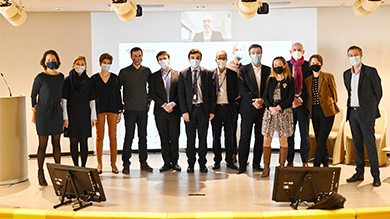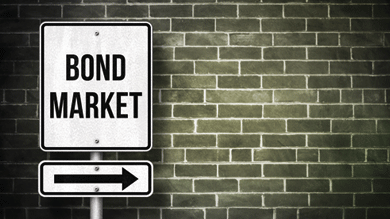Solar power still accounts for a very small proportion of French electricity generation – around 2% ─ although figures have climbed steeply over the past ten years. From an international standpoint, France generates around 2% of world photovoltaic solar power, lagging far behind China (32%), the United States (15%), Japan (11%) and Germany (8%) (source: International Energy Agency, 2018). Yet the country enjoys one of the sunniest climates in Europe and harbors strong potential to produce this carbon-free energy source, so just what lies behind the sluggish take-up for solar power in France?
Nuclear decommissioning will be a vital precondition for the development of renewable energy
France’s decision to focus on nuclear power in the 1960s offers an initial response to this question, as this energy source still accounts for more than 70% of the country’s electricity output. “Nuclear power generation does not emit CO2, so France already enjoys carbon-free electricity, complying with the goals set out in the Paris Agreement”, explains Sybille Grandgeorge, Industry Banker Power & Renewables at Natixis Corporate & Investment Banking. This power source offers the added advantage of providing round-the-clock energy, while photovoltaic power is variable.
Nuclear electricity prices are rising relentlessly amid falling renewable energy prices as a result of technological progress and economies of scale.
Sybille Grandgeorge, Industry Banker Power & Renewables at Natixis Corporate & Investment Banking
Nuclear energy prices are relatively competitive in France for now, but they do not incorporate development or decommissioning costs, yet the cost of some new power stations is seemingly spiraling out of control. By way of illustration, the Flamanville project – initially set to cost €3.3bn over five years – was subsequently re-assessed by the French Cour des comptes (court of audit) at €19.1bn for a duration of 16 years after safety requirements were bolstered following the Fukushima disaster. “Nuclear electricity prices are rising relentlessly amid falling renewable energy prices as a result of technological progress and economies of scale” she adds.
Solar power – the question of variable energy
Another point worth bearing in mind is that solar power is variable, and this also accounts for its sloth-like development in France. Meanwhile more flexible hydro energy is proving much more popular and amounts to 47% of the French renewable energy mix (source: Observ’ER). Hydro power can be regulated via dams and pumped-storage techniques, while solar power – and wind – are by definition dependent on the prevailing weather conditions. This kind of electricity is therefore difficult to store, and a back-up source is required when power generation is scanty.
Currently prevalent nuclear power ensures steady supply, explaining French President Macron’s solid support for the nuclear industry, stating that “our energy and ecological future depend on nuclear power”, which he describes as “non-intermittent energy that emits the least CO2”.
However, targets in the French Energy-Climate Act are for nuclear to comprise 50% of the electricity mix out to 2035, entailing the closure of 14 nuclear reactors equating to 11.7 GW in installed capacity – including the two Fessenheim reactors. Meanwhile, the French Multiannual Energy Program (Programmation pluriannuelle de l’énergie or PPE) seeks to double renewable capacity to 113 GW out to 2028 vs. 2017 figures. Programs to support energy efficiency and exit the fossil fuel industry – particularly by electrifying sectors such as heating and transport i.e. individual mobility – should fuel the transition to a low-carbon economy with the ultimate aim of achieving climate neutrality out to 2050, while also ensuring that France upholds its energy independence.
Storage offers a response to variable generation
A number of options are available to ensure uninterrupted supply when more than 50% of power is derived from renewable sources. For example, flexible gas-fired power plants can generate back-up power for a small number of hours each year. In some countries – such as Germany – these power plants are covered by a specific individual framework that remunerates on stored capacity and rewards their role in safeguarding the power grid’s balance. However, “these power sources do emit CO2, while carbon capture techniques are still expensive and experimental for now, not to mention the challenges of burying CO2 once it has been contained”, explains Ivan Pavlovic, Senior Energy & Sustainable Development Specialist at Natixis Corporate & Investment Banking. Using gas as back-up is therefore more of a stepping stone along the energy transition path, meaning that low-carbon options will need to be developed for the longer term.
Private investors are willing to step in to support the development of the green hydrogen industry, alongside much-needed support from the state.
Ivan Pavlovic, Senior Energy & Sustainable Development Specialist at Natixis Corporate & Investment Banking
Power providers are increasingly developing electricity storage systems based on lithium-ion technology: a prime example of this is Corsica Sole, No.1 on the French market (see inset). Meanwhile storage has also become a regular component in the French government’s calls for tenders, supervised by the French Energy Regulation Commission. This technology is particularly useful in managing daily peaks, as electricity generated during daytime hours of maximum sunlight is stored and deployed in the evening when demand hits a peak. However, capacity is limited, and this technology cannot be used to address seasonal fluctuations.
Green hydrogen – produced by renewable electricity-powered electrolysis – offers a more long-term response, especially for power storage across the seasons. Hydrogen is produced and stored when renewable energy can generate a surplus and is then available for periods of high demand in the winter. Economic stimulus programs launched in the aftermath of the Covid-19 crisis point to a determination to develop this industry on a broad scale, with the aim of bringing down generation costs and boosting the sector’s competitiveness. “Incorporating ambitious hydrogen programs reflects a clear ramp-up in support measures, with €7bn in France out to 2030 as compared with €100m in the 2018 Hulot plan” adds Ivan Pavlovic. He also notes that “private investors are willing to step in to support the development of the green hydrogen industry, alongside much-needed support from the state.”
Ambitious goals but a fainthearted reality
This begs the question: can we expect solar power to pick up in France? The solar energy component of the country’s Multiannual Energy Program is ambitious, with photovoltaic capacity poised to double from 10.6 GW currently to 20.1 GW in 2023, and then again to 44 GW in 2028. Regrettably, looking at the reality of the situation, the industry is failing to hit this pace of growth, with only 0.7 GW connected in 2019 followed by the same figure in 2020 (source: Observ’ER). The sector will need to more than triple its speed of growth and connect 3.6 GW each year if it is to succeed in achieving its targets.
Solar projects in France are developed in regions where urban growth and agricultural requirements do not compete so much for land, such as the Occitanie and Nouvelle Aquitaine regions
Stéphane Pasquier, CEO of BPCE Energéco
Key roles for land, social acceptability and regulation
A number of factors can explain the French solar power sector’s struggle to really get off the ground. The Covid-19 crisis admittedly slowed photovoltaic panel deliveries considerably, which mostly arrive from China, leading to delays in project development. However, the primary reason is structural – it’s all about land. “A vital prerequisite to developing an onshore project is finding a piece of land where there is no conflict with agricultural use and no real estate pressure, while it also needs to be socially acceptable to boot” explains Stéphane Pasquier, CEO of BPCE Energéco. “This explains why projects in France are developed in regions where urban growth and agricultural requirements do not compete so much for land, such as the Occitanie and Nouvelle Aquitaine regions”.
If we also take account of fairly prolonged planning permission procedures – building permits, environmental impact assessments, public surveys – France is struggling to develop the number of projects the country would like.
One-stop shop versus calls for tenders
By way of reminder, renewable electricity in France is bought by grid managers (mainly EDF, via Enedis) at a regulated price (i.e. with additional remuneration). The set-up comprises two coinciding systems: projects of under 100kWp with a one-stop shop system and a purchase obligation, which means that kWh generated are automatically purchased by the grid on the basis of a guaranteed contract at a set price for a period of 20 years; projects of more than 100kWp are required to undergo a call for tenders to be eligible for support via a purchase price up to 500 kWp and then additional remuneration thereafter.
The French Ministry of Ecological Transition announced that it would raise the ceiling for the one-stop shop system to 500kWp with the aim of shoring up the industry, although this move has not yet been implemented. This chimes with targets set out in the Multiannual Energy Program to promote the development of more competitive large onshore power stations on brownfield sites, abandoned motorway land, military areas, as well as the installation of solar roof panels.
Developing solar roof panels is a crucial source of development
Solar roof panel installation also offers a major avenue for developing renewable power, as there are no issues on land use, while they are also seen as a more socially acceptable option. France harbors vast potential in this field as few industrial facilities have so far been fitted with roof panels. However, projects are smaller, economies of scales are lesser and a different type of expertise is therefore required. “These projects are developed by mid-sized regional firms, such as APEX Energies, Arkolia Energies, Corsica Sole and Tenergie, which specialize in roof panel power generation and are able to handle the fragmented nature of this kind of project” explains Amaury Schoenauer, Head of Structured Finance at Caisse d’Epargne CEPAC.
Meanwhile on a smaller scale, agrophotovoltaics – also known as agrivoltaics or solar agriculture – combines crop protection with power generation, while also providing additional revenue for farmers. Tilting shadehouses holding photovoltaic panels protect crops from excessive sunlight and also help reduce water needs. When crops require sunlight, shades can then be tilted vertically. “Shadehouses and photovoltaic greenhouse-grown crops are already common in the south of France and in island areas” explains Stéphane Pasquier. “Rolling out these systems on a wider scale is a real step forward”.
Industrial players will have every reason to take out long-term contracts to lock in their energy prices.
Amaury Schoenauer, Head of Structured Finance at Caisse d’Epargne CEPAC
Grid parity drives a real paradigm change
The future of the solar power industry in France will ultimately hinge on reducing generation costs and thereby releasing projects from the need for state subsidies and purchase contracts. “Solar power prices are gradually reaching grid parity – or market price – without additional remuneration. This is already happening in some areas in the south of France, where prices are even below market rates. We are seeing a true paradigm change” states Amaury Schoenauer, who also notes that this grid parity facilitates the development of Corporate Power Purchase Agreements (CPPA), i.e. purchase contracts between suppliers and industrial companies. “With the economy’s growing electrification, France’s electricity needs are set to escalate, but if generation cannot keep up, prices could well surge. Industrial players will then have every reason to take out long-term contracts to lock in their energy prices.”
The current situation across the renewable power sector bodes well for this change. “Electricity market prices have surpassed renewable power purchase prices over the past several months. So the additional remuneration system is positive for the government, ushering in a mechanism to offset the hefty state subsidiaries awarded to promote growth in the sector” notes Stéphane Pasquier. Perhaps we could call it a virtuous circle of sorts.
Corsica Sole, French No.1 in solar power storage
Corsica Sole, Corsica’s leading independent energy producer and a key photovoltaic company in France, is also the No.1 operator of energy storage units in France, but just what lies behind the company’s success? Amaury Schoenauer, Head of Structured Finance at Caisse d’Epargne CEPAC tells us more.
“Corsica Sole operates in Corsica, the French Antilles and Réunion island, in non-interconnected areas that are not – or are only to a limited degree such as Corsica – connected to the power grid on the continent. In view of their climate and geographical features, the ensuing logistics restrictions, and the small size of these electricity systems, thermal technologies tend to dominate. These regions have therefore ended up with a carbon-intensive electricity mix and have set out ambitious renewable power development goals with a view to reducing their fossil fuel dependency. Corsica Sole therefore decided to focus particularly on storage technologies, which are crucial for island networks to boost their maximum renewable energy capacity in the broader energy mix. Groupe BPCE has supported Corsica Sole in its expansion over the past ten years, as the company has developed a trusted relationship with Caisse d’Epargne CEPAC and our structured finance teams. In April 2021, we hit a fresh milestone as sustainable investment* manager Mirova took a stake in the company. This fundraising will “accelerate the change of scale of our development while enabling us to stay true to our values” states Michael Coudyser, CEO and founder of Corsica Sole, in a press release.”
*Mirova is an affiliate of Natixis Investment Managers (Groupe BPCE)














